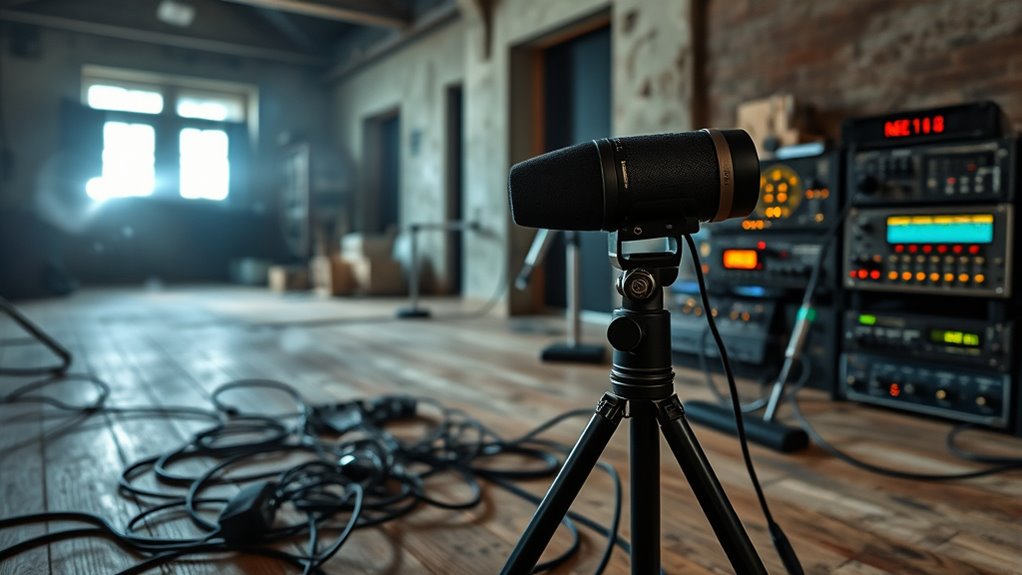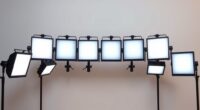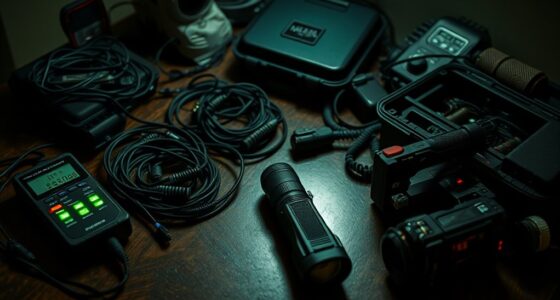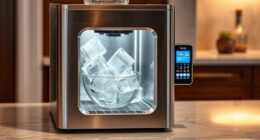To capture paranormal audio, you need high-quality, sensitive microphones like shotgun, condenser, or parabolic to focus on faint sounds while minimizing noise. Use quiet environments and proper placement away from external interference. Record with multiple synchronized tracks and employ digital signal processing to analyze and filter anomalies. Expert techniques like spectral analysis help distinguish genuine signals from background noise. Continue exploring to discover more advanced methods for capturing and validating eerie sounds.
Key Takeaways
- Use high-quality directional microphones and sensitive recorders to isolate faint paranormal sounds from ambient noise.
- Conduct recordings in controlled, soundproof environments to minimize external interference and vibrations.
- Employ spectral analysis and filtering techniques to identify anomalies and distinguish genuine signals from background noise.
- Record multiple audio channels simultaneously and document environmental conditions for accurate validation.
- Collaborate with acousticians or audio experts to interpret spectral anomalies and confirm the authenticity of paranormal sounds.
Essential Equipment for Paranormal Audio Recording
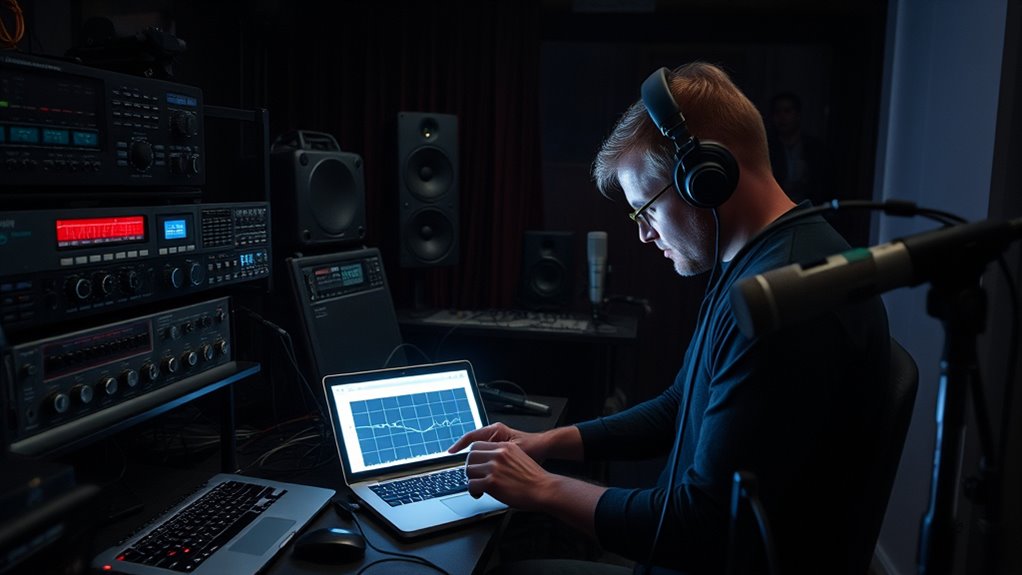
To effectively capture paranormal audio, you need the right equipment that can detect subtle sounds and minimize background noise. You’ll want a high-quality digital recorder with excellent sensitivity and low self-noise. Look for devices that offer multiple input options, allowing you to connect external microphones or accessories. A directional microphone, such as a shotgun mic, helps focus on specific sounds and reduces ambient noise. Noise reduction accessories like windshields or pop filters are essential to keep unwanted sounds out. Additionally, a good pair of headphones ensures you can monitor recordings in real-time, catching faint anomalies. Battery life matters too, so choose equipment with long-lasting power. Incorporating advanced filtering technology can further enhance sound clarity by reducing background interference. With reliable gear, you’ll increase your chances of capturing those eerie, unexplained sounds accurately.
Selecting the Right Microphones for Eerie Sounds
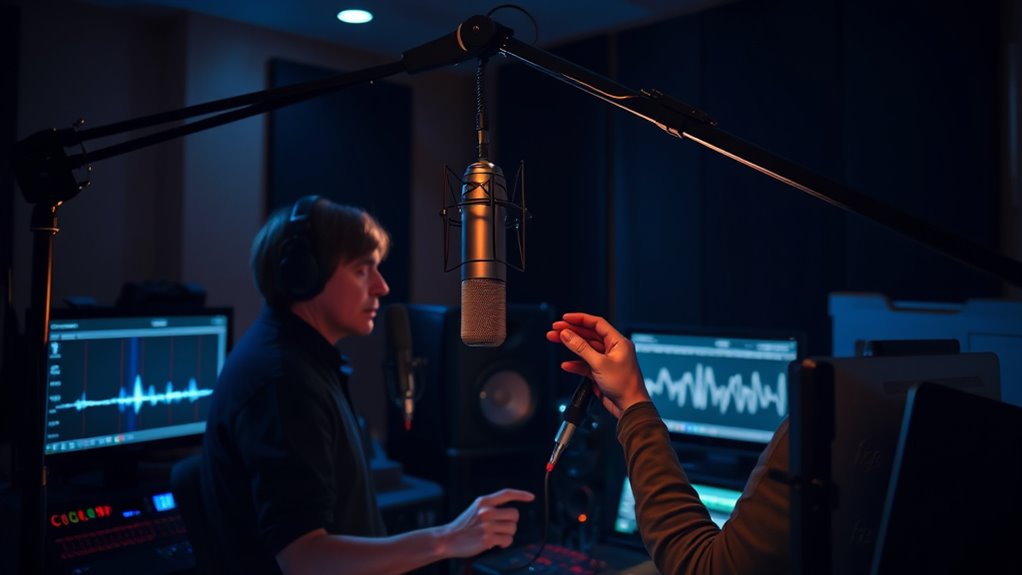
Choosing the right microphone is essential for capturing eerie, subtle sounds that often accompany paranormal investigations. You need equipment sensitive enough to pick up faint whispers, distant footsteps, or unexplained noises. Consider using a shotgun mic for directional focus, or a condenser mic for capturing ambient sounds. These options help isolate or emphasize specific audio cues. To visualize, think of the microphones like this:
| Microphone Type | Best For |
|---|---|
| Shotgun Mic | Isolating distant sounds |
| Lavalier Mic | Capturing close, subtle whispers |
| Parabolic Mic | Amplifying far-off noises |
| Condenser Mic | Recording ambient atmospheres |
Choosing wisely guarantees you don’t miss those fleeting, paranormal sounds that might be your only evidence. Additionally, understanding the importance of audio clarity can make all the difference in interpreting the recordings accurately.
Optimal Recording Environments and Setup
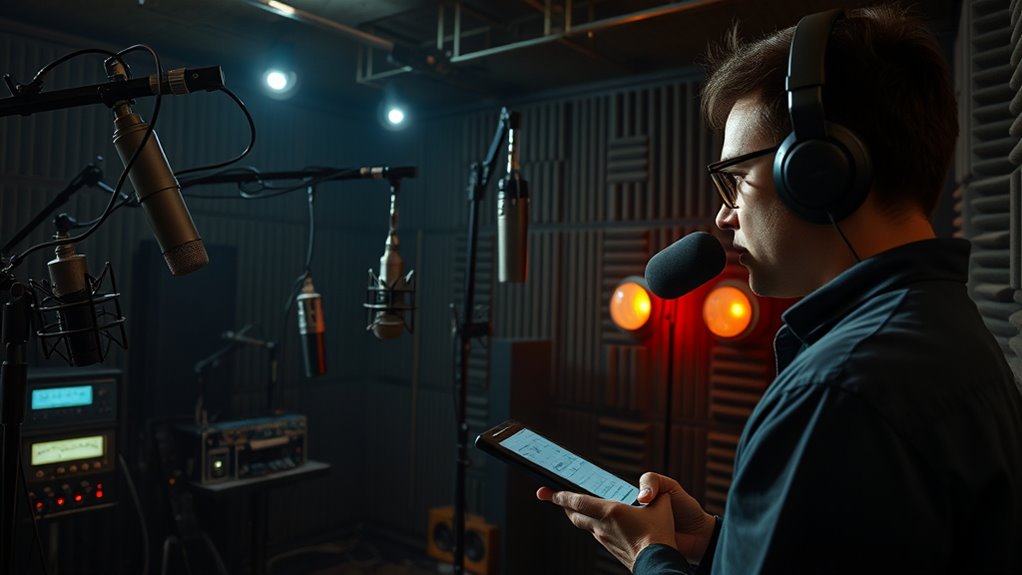
A well-planned recording environment can make all the difference when capturing paranormal sounds. Choose a quiet, controlled space with minimal external noise and vibrations. Turn off unnecessary electronics that might introduce interference. Use soundproofing materials like foam panels or heavy curtains to dampen echo and background noise. Position your microphone away from windows, doors, and vents to reduce drafts and ambient sounds. Guarantee your recording device is stable, ideally mounted on a tripod or solid surface. Maintain consistent temperature and humidity levels to prevent equipment issues. Keep the environment free of distractions, allowing you to focus solely on capturing subtle anomalies. A carefully prepared setup enhances your chances of isolating and recording paranormal audio with clarity and precision. Incorporating AI-powered noise reduction tools can further improve audio quality by filtering out residual background sounds.
Techniques for Minimizing Background Noise
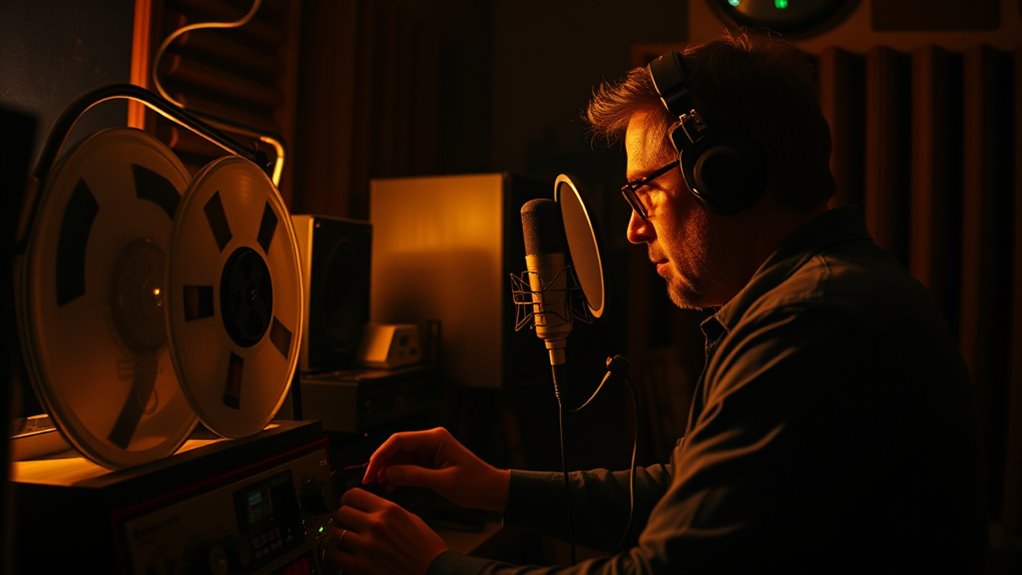
Effective noise reduction starts with identifying and eliminating common sources of interference. You should focus on controlling your environment to minimize unwanted sounds. First, choose a quiet location away from traffic, machinery, or human activity. Second, turn off or unplug nearby electronics that generate hums or static. Third, use directional microphones to focus on the source and block out surrounding noise. Fourth, employ physical barriers like soundproof panels or blankets to absorb background sounds. Additionally, consider using windshields or pop filters to reduce airflow noise. By actively managing these factors, you create a cleaner recording environment, making it easier to capture authentic paranormal sounds without interference. Proper soundproofing techniques are essential for minimizing ambient noise and ensuring higher-quality audio. This targeted approach assures higher-quality audio, essential for credible evidence collection.
The Role of Digital Signal Processing in Sound Analysis

Digital signal processing plays a vital role in analyzing paranormal sounds by applying noise filtering techniques to isolate relevant audio. Spectral analysis methods help you visualize and identify unusual frequencies that may indicate paranormal activity. Mastering these tools allows you to enhance recordings and uncover hidden sounds that might otherwise go unnoticed. Incorporating Fokos can provide additional insights into effective sound analysis techniques used by enthusiasts and professionals alike.
Noise Filtering Techniques
Noise filtering techniques are essential for isolating genuine paranormal sounds from background interference in audio recordings. These methods improve clarity, making it easier to identify unusual phenomena. Digital signal processing offers powerful tools for this purpose. You can apply:
- Band-pass filters to focus on specific frequency ranges where paranormal sounds are expected.
- Adaptive filtering to continuously adjust and reduce consistent background noise.
- Notch filters to eliminate persistent hums or electrical interference.
- Spectral subtraction to remove broadband noise while preserving the desired signal.
- Understanding the audio quality of recordings is crucial to select appropriate filtering methods and achieve accurate analysis.
Spectral Analysis Methods
Spectral analysis methods use digital signal processing to examine the frequency components within audio recordings, enabling sound engineers to distinguish paranormal sounds from background noise. By transforming time-domain audio data into the frequency domain, techniques like the Fourier Transform reveal hidden spectral details. This process helps identify unusual or anomalous frequencies that don’t match common environmental sounds. You can visualize these frequencies using spectrograms, which display how sound energy varies over time. This visual insight allows you to isolate potential paranormal signals from normal sounds, making analysis more precise. Spectral analysis also aids in filtering out unwanted noise, sharpening the focus on suspicious audio cues. Additionally, understanding the principles of sound design helps engineers craft more convincing audio effects for paranormal media. Overall, it’s a crucial tool in the modern sound engineer’s arsenal for paranormal investigation.
Identifying Anomalous Audio Phenomena
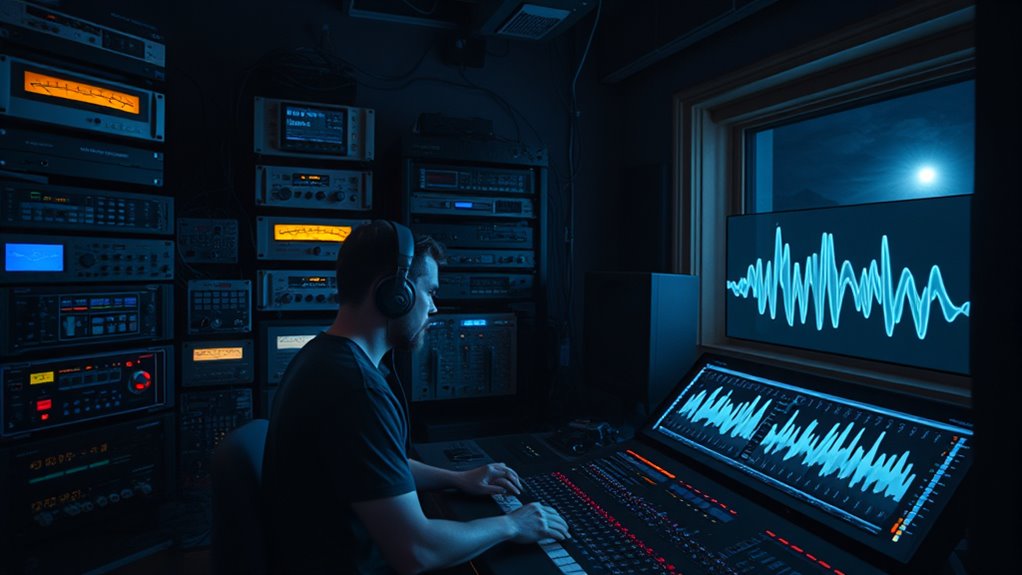
When analyzing audio recordings for paranormal activity, identifying anomalous phenomena requires a keen ear and careful scrutiny. You must distinguish genuine anomalies from background noise or technical artifacts. Listen for irregular sounds that don’t match natural patterns, such as unexplainable voices or sudden shifts in volume. Pay attention to sounds that appear inconsistent with the environment or recording equipment. Use your experience to spot subtle anomalies that may otherwise go unnoticed. Focus on these key indicators:
- Unusual voices or whispers not originating from known sources
- Sudden, unexplained volume changes or distortions
- Sounds that seem to “float” or drift without a clear cause
- Frequencies or noises inconsistent with the environment or recording context
Additionally, recognizing the different types of ice cream can sometimes help in correlating audio phenomena with specific environments or events. Mastering this process helps you identify truly anomalous phenomena worth further investigation.
Using Spectrum Analyzers to Detect Unusual Frequencies
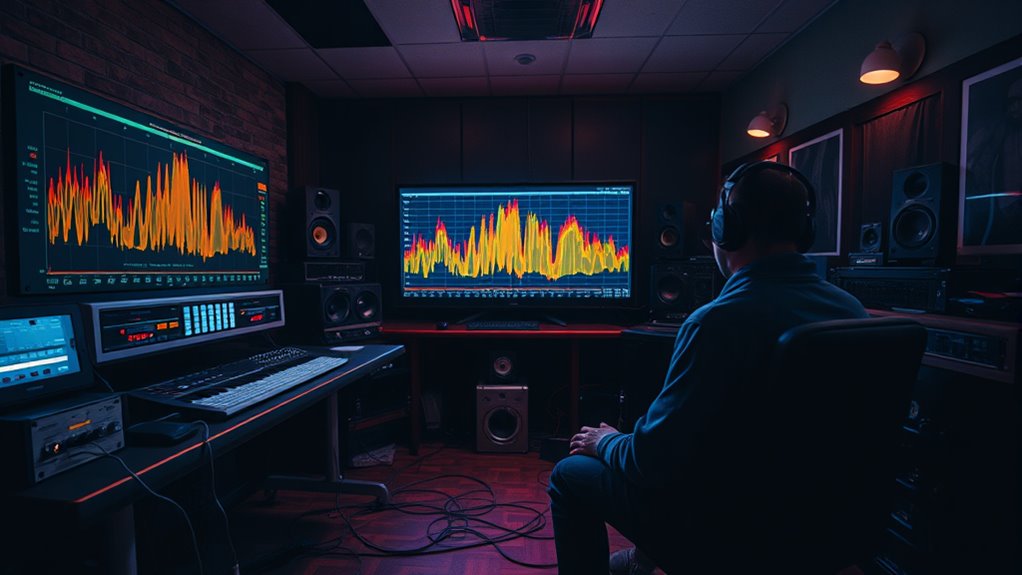
Using spectrum analyzers allows you to spot anomalous signals that stand out from normal background noise. By analyzing frequency patterns, you can identify unusual or unexplained audio phenomena. This helps you distinguish between natural sounds and potential paranormal activity with greater accuracy. Incorporating Kia Tuning techniques can also enhance your understanding of how different frequencies are managed and manipulated in audio recordings.
Identifying Anomalous Signals
To identify anomalous signals, you need to analyze the audio spectrum carefully with a spectrum analyzer. Look for frequencies that stand out from the typical background noise or are inconsistent with known sources. Unusual signals may appear as sharp spikes or irregular patterns that don’t match natural or electronic sounds. Focus on these key indicators:
- Unexpected frequency spikes outside normal ranges
- Sudden changes in amplitude or intensity
- Persistent or repeating signals that lack a clear source
- Inconsistencies with ambient environmental sounds
Additionally, understanding how to interpret audio spectrum analysis can help distinguish genuine paranormal signals from false positives.
Frequency Pattern Analysis
Frequency pattern analysis involves examining the audio spectrum in detail to uncover unusual signals that may indicate paranormal activity. Using spectrum analyzers, you can visualize sound frequencies over time, helping you spot anomalies that stand out from typical environmental noise. Look for persistent or atypical peaks that don’t match natural sounds or equipment artifacts. Unusual frequency patterns might appear as sharp spikes, consistent hums, or irregular oscillations. By analyzing these patterns, you can differentiate between normal background noise and potential paranormal signals. This technique allows you to focus your attention on specific frequencies that warrant further investigation. Precision and careful observation are key, as subtle anomalies could be the clues that reveal the presence of something beyond ordinary understanding.
Differentiating Natural vs. Unusual
When analyzing audio spectra, distinguishing between natural environmental sounds and unusual frequencies is crucial for identifying potential paranormal signals. You need to recognize what normal sounds look like in the spectrum and spot anomalies. Unusual frequencies often appear as sharp spikes or inconsistent patterns that don’t match natural sources. To differentiate them, consider these points:
- Check for consistent patterns over time versus sporadic spikes.
- Compare frequencies with known environmental or technical sources.
- Look for sounds that don’t correspond to weather, machinery, or human activity.
- Use spectral zooming to identify isolated high or low-frequency anomalies.
The Importance of Multi-Track Recording and Synchronization

Multi-track recording and synchronization are crucial tools for sound engineers aiming to capture paranormal audio with clarity and accuracy. By recording multiple channels simultaneously, you can isolate different sounds—like whispers, footsteps, or electronic interference—making it easier to analyze and identify anomalies. Synchronization ensures all tracks align perfectly in time, which helps distinguish genuine paranormal signals from background noise or technical artifacts. Using multi-track setups allows you to overlay audio layers, enhancing subtle sounds that might otherwise go unnoticed. This detailed approach helps you create a thorough audio picture of the phenomenon. Accurate synchronization also makes it easier to compare recordings taken at different times or locations, increasing your chances of verifying paranormal activity reliably. In short, multi-track recording and synchronization are essential for precise, credible paranormal audio documentation.
Documenting and Cataloging Paranormal Audio Files

To guarantee your paranormal recordings are useful later, you need to organize your files effectively. Using consistent metadata tagging methods helps you quickly identify important details, while proper archiving preserves digital evidence securely. Clear documentation practices make your recordings reliable and easy to access when needed.
Organized File Management
Effective organized file management is essential for sound engineers documenting paranormal audio, ensuring that each recording is easily accessible and properly categorized. Proper documentation helps prevent confusion and saves time during analysis. You should implement a system that clearly labels files with relevant details like date, location, and recording conditions. Use folders and subfolders to separate different investigations or locations. Consistent naming conventions make files easier to find later. Additionally, keep a log or spreadsheet tracking key information about each recording. This practice streamlines your workflow and maintains data integrity. Here are four key strategies:
- Use descriptive filenames with dates and locations
- Create dedicated folders for each investigation
- Maintain a detailed log or spreadsheet
- Regularly back up all files to prevent data loss
Metadata Tagging Methods
Metadata tagging is essential for organizing and retrieving paranormal audio files efficiently. When you record and analyze these unique sounds, proper tags help you quickly locate specific clips, whether by date, location, or phenomenon. You should include details like recording date, time, sensor settings, and environmental conditions. Tagging with keywords such as “electronic voice phenomenon” or “EVP” allows for easy filtering during reviews. Use consistent terminology to prevent confusion later. Embedding metadata directly into audio files ensures your information stays with the file, even if copied or moved. Additionally, consider adding investigator notes or hypotheses as custom tags. Effective metadata tagging streamlines your workflow and ensures critical data isn’t lost amid the vast amount of recordings you collect.
Archiving Digital Evidence
When archiving digital evidence, maintaining a detailed and organized catalog of your paranormal audio files is essential for efficient analysis and verification. You need a systematic approach to ensure quick retrieval and proper documentation. First, create a consistent naming convention that includes date, location, and key details. Second, store files in clearly labeled folders sorted by date or event. Third, back up all recordings to multiple secure locations to prevent data loss. Lastly, keep a log that records metadata like recording equipment, conditions, and any observations during capture. This disciplined process allows you to easily reference specific files, verify authenticity, and support your findings with clear documentation. Proper archiving is vital in building credibility and advancing your paranormal investigations.
Interpreting and Validating Unexplained Sounds
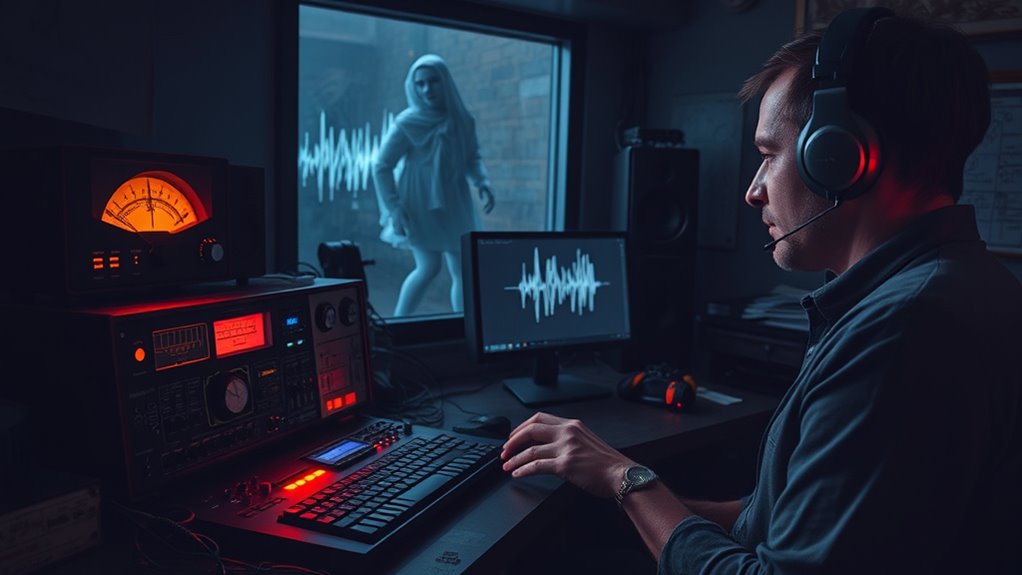
Interpreting and validating unexplained sounds demands a critical approach, as many noises can have natural or mechanical origins. You need to carefully analyze recordings, distinguishing between environmental factors and potential paranormal activity. Cross-referencing audio with known sources helps filter out background noise, machinery, or interference. Consulting with experts, such as acousticians or engineers, can provide valuable insights into whether sounds are natural phenomena or something unusual. You should also consider the context—timing, location, and equipment used—to assess credibility. Document everything meticulously, including equipment settings and environmental conditions. Remember, skepticism is essential; just because a sound seems strange doesn’t mean it’s paranormal. Validation involves eliminating all natural explanations before considering the possibility of genuine unexplained phenomena.
Frequently Asked Questions
How Do Sound Engineers Differentiate Between Natural and Paranormal Sounds?
You differentiate between natural and paranormal sounds by analyzing audio recordings for anomalies that don’t match typical environmental noise. You listen carefully for unexplained voices, whispers, or sounds that occur without a clear source. You also use specialized equipment, like electromagnetic field meters and audio filters, to identify unusual activity. Comparing recordings over time helps you spot patterns that suggest paranormal presence rather than natural causes.
What Are Common Misconceptions About Capturing Paranormal Audio?
Many believe capturing paranormal audio is easy or guaranteed with certain equipment, but that’s a misconception. You can’t always guarantee you’ll find ghostly sounds, because they’re rare and unpredictable. Also, some think that all strange noises are paranormal, but many are just natural or environmental sounds. You need patience, proper equipment, and critical listening skills. Paranormal audio isn’t simple, and it requires careful analysis to avoid false positives.
Can Specific Equipment Guarantee the Detection of Spirits or Entities?
No equipment can guarantee you’ll catch spirits or entities; it’s like trying to catch shadows in a fog—elusive and unpredictable. Your gear acts as a flashlight illuminating potential signals, but ghosts remain hidden in the mist. You need a keen ear, patience, and an open mind. Even the best tools can’t summon or confirm paranormal presence—they simply provide clues, leaving the rest to your interpretation and intuition.
How Do Environmental Factors Influence Paranormal Sound Recordings?
Environmental factors greatly influence your paranormal sound recordings. You need to contemplate background noise, like wind or traffic, which can mask or mimic ghostly sounds. Temperature fluctuations and humidity can also affect equipment performance, creating artifacts or distortions. Vibrations from footsteps or nearby machinery may be recorded as strange noises. By controlling or accounting for these factors, you increase your chances of capturing authentic paranormal audio without interference.
What Ethical Considerations Exist in Recording Paranormal Phenomena?
You need to respect privacy and obtain permission from individuals before recording, ensuring you’re not violating their rights. Be honest about your intentions, avoiding sensationalism that might mislead others. Handle recordings responsibly, safeguarding sensitive content and not sharing evidence without consent. Consider potential emotional impacts on those involved, and always prioritize ethical standards over curiosity or fame. By doing so, you maintain integrity and foster trust in your paranormal investigations.
Conclusion
By mastering your equipment and honing your techniques, you become a detective of the unseen world, capturing whispers from beyond. Each carefully recorded and analyzed sound brings you closer to revealing mysteries lurking in the shadows. Remember, patience and precision are your allies in this paranormal symphony. With every unexplained noise documented, you’re weaving a tapestry of ghostly echoes, transforming fleeting whispers into a story that lingers long after the recording stops.
